Related Research Articles

Kudzu is a group of climbing, coiling, and trailing perennial vines native to much of East Asia, Southeast Asia, and some Pacific islands, but invasive in many parts of the world, primarily North America.

Lobata is a district of São Tomé and Príncipe, on São Tomé Island. Its area is 105 km2 (41 sq mi), and its population is 19,365 (2012). The district seat is Guadalupe. It is divided into the four statistical subdistricts Guadalupe, Santo Amaro, Conde and Micoló.
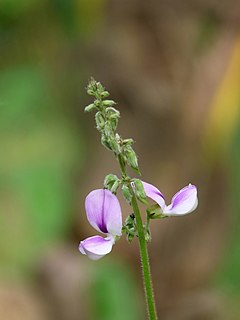
Pueraria is a genus of 15–20 species of plants native to Asia.

Quercus lobata, commonly called the valley oak or roble, grows into the largest of North American oaks. It is endemic to California, growing in interior valleys and foothills from Siskiyou County to San Diego County. Mature specimens may attain an age of up to 600 years. This deciduous oak requires year-round access to groundwater.

Daidzein is a naturally occurring compound found exclusively in soybeans and other legumes and structurally belongs to a class of compounds known as isoflavones. Daidzein and other isoflavones are produced in plants through the phenylpropanoid pathway of secondary metabolism and are used as signal carriers, and defense responses to pathogenic attacks. In humans, recent research has shown the viability of using daidzein in medicine for menopausal relief, osteoporosis, blood cholesterol, and lowering the risk of some hormone-related cancers, and heart disease.
São Tomé and Principe Championship is the top division of the São Toméan Football Federation. Currently, there are 16 teams participating at the tier-one competitions of São Tomé and Principe, 10 teams from São Tomé Island and 6 teams from Príncipe Island.
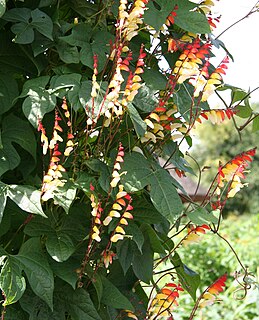
Ipomoea lobata, the fire vine, firecracker vine or Spanish flag, is a species of flowering plant in the family Convolvulaceae, native to Mexico and Brazil.
The Kenyan big-eared free-tailed bat is a species of bat in the family Molossidae. It is found in Kenya and Zimbabwe. Its natural habitat is dry savanna.

Deroplatys is a genus of mantis in the family Deroplatyidae. They are native to Asia and several share the common name of dead leaf mantis.
Rafflesia lobata is a parasitic plant species of the genus Rafflesia. It is endemic to the Philippine island of Panay, particularly the mountains of Antique and Iloilo provinces. This is the second species recorded from the island of Panay. One of the most distinctive features of Rafflesia lobata is that some populations have flowers with a lobed diaphragm that opens outward. Nearly all other Rafflesia species have diaphragms that curve inward. This feature is polymorphic in R. lobata. As shown in the photos below, in some populations the diaphragm curves inward and may be 3- or 6-lobed. Note the 6-lobed flower also has 6 perigone lobes. It remains to be seen whether flower merousity has phylogenetic significance that should be taxonomically recognized. Some populations of R. manillana, such as one at Bolos Point, Cagayan Valley, Luzon, also have flowers with lobed, outwardly curving diaphragms.

Daidzin is a natural organic compound in the class of phytochemicals known as isoflavones. Daidzin can be found in Japanese plant kudzu and from soybean leaves.

Puerarin, one of several known isoflavones, is found in a number of plants and herbs, such as the root of Pueraria notably of the kudzu plant.
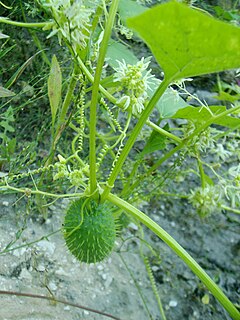
Echinocystis is a monotypic genus in the gourd family, Cucurbitaceae. The sole species is E. lobata, commonly called wild cucumber, prickly cucumber or bur cucumber. It is an annual, sprawling plant that is native to North America.
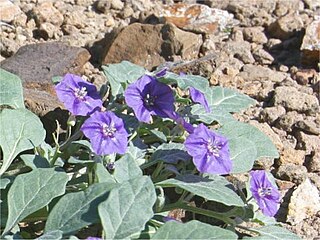
Quincula is a monotypic genus of flowering plants in the nightshade family, Solanaceae. The sole species it contains, Quincula lobata, is commonly known as Chinese lantern, lobed groundcherry, or purple groundcherry.
The New Zealand musk duck, also known as de Lautour's duck, is an extinct stiff-tailed duck native to New Zealand. It is only known from subfossil bones. Its closest relative was the living Australian musk duck Biziura lobata, with which it has sometimes been combined.

Lobata is an unincorporated community in Mingo County, West Virginia, United States. Lobata is located on the Tug Fork and West Virginia Route 49, 5.2 miles (8.4 km) east-southeast of Williamson. Lobata had a post office, which closed on July 1, 1989.

Porites lobata, known by the common name lobe coral, is a species of stony coral in the family Poritidae. It is found growing on coral reefs in tropical parts of the Indian and Pacific Oceans.

Pterolophia is a genus of longhorn beetles of the subfamily Lamiinae, containing the following species:

Mirificin, also known as daidzein 8-C-(6-apiofuranosylglucoside), is an isoflavone that is found in Pueraria mirifica and Pueraria lobata. It has estrogenic activity and hence is a phytoestrogen.
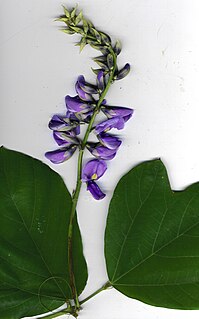
Pueraria montana var. lobata, the East Asian arrowroot, is a perennial plant in the family Fabaceae.
References
- ↑ BioLib.cz - Pterolophia lobata. Retrieved on 8 September 2014.